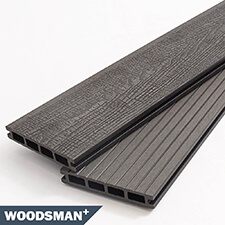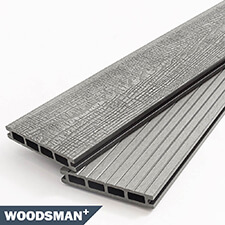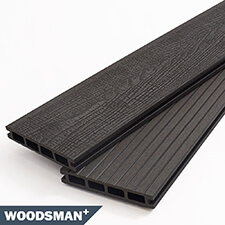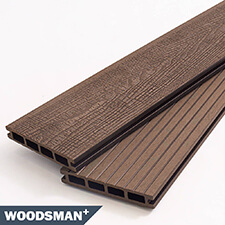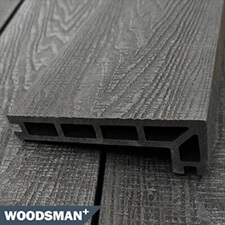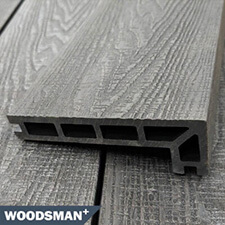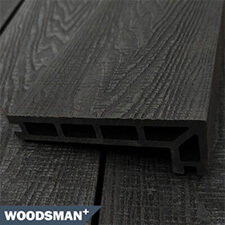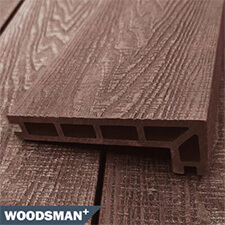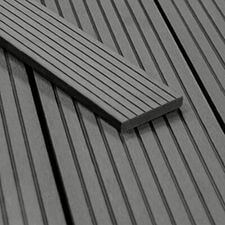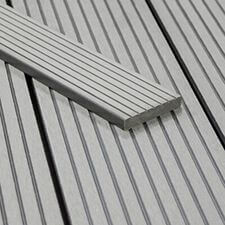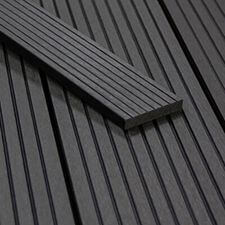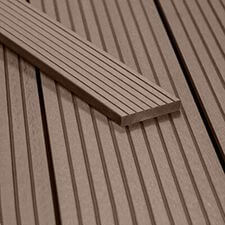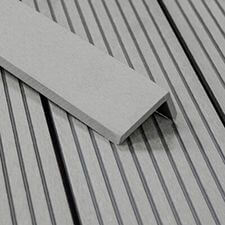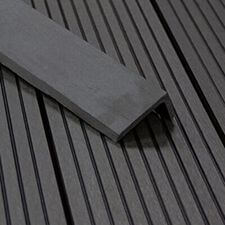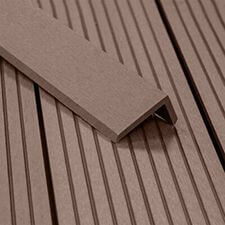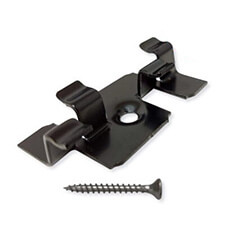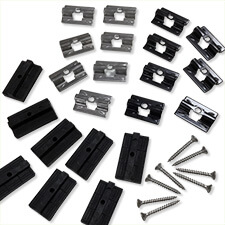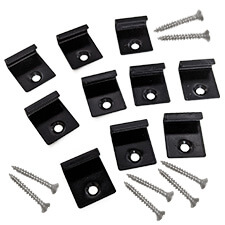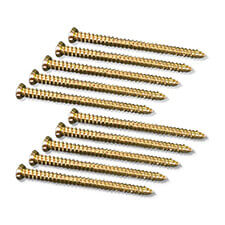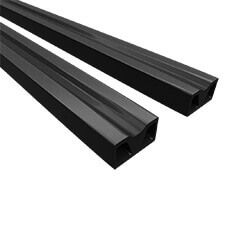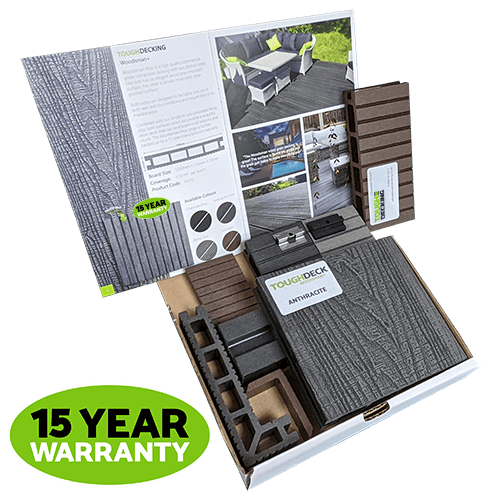No products in the basket.
Home /
Archives: FAQs
How do I track my delivery?
When you receive your order invoice by email it will include a tracking link with parcel/consignment reference. If you click the link and enter your reference number you can track your delivery. Depending on the courier/carrier you maybe asked to enter your delivery postcode. If you have signed up for a Tough Decking Account, you […]
Read more »My composite decking boards have become damaged. Are these replaced under warranty?
Because the decking is uniquely uncapped, minor scratches or dents caused by pets or heavy garden furniture can be easily sanded out with fine grade sandpaper. If the boards do warp, splinter or break, then please contact our technical team at your earliest convenience.
Read more »I’ve ordered too much decking. Can it be returned for a refund?
Unwanted products can be returned for a full refund within 30 days from the date you took delivery. Returned goods must be returned in their original unused condition. Further details about our refund and returns process can be found here: Returns & Refunds
Read more »My composite decking boards have moved on the joists. What should I do?
If your composite decking boards have moved on the joists, there are a few steps you can take to fix the problem: Identify the cause: First, try to identify the cause of the movement. It could be due to expansion and contraction caused by changes in temperature and moisture levels, or it could be due […]
Read more »How do I fix my Fascia Skirting or L Profile trim to my decking?
To fix Fascia Skirting or L Profile trim to your composite decking by Tough Decking, you can follow these steps. Start by cutting the fascia skirting or L profile trim to the correct length and width to fit around the perimeter of your deck. Use a chalk line or other straight edge to mark a […]
Read more »What is meant by a ‘staggered joint’?
A staggered joint refers to a method of joining two boards end-to-end in a way that creates a more visually appealing and structurally sound deck surface. Instead of having all the seams between boards lined up in a straight line, a staggered joint involves offsetting the seams so that they are not directly aligned. This […]
Read more »What does expansion gap mean?
An expansion gap refers to the space left between the ends of the decking boards to accommodate any potential expansion or contraction of the material due to changes in temperature and humidity.
Read more »Why should expansion and contraction be factored in when installing?
Expansion and contraction should be factored in when installing composite decking because the material can expand and contract with changes in temperature and humidity. Composite decking is made of a combination of wood fibres and plastic, which can react differently to environmental changes. During hot weather, the composite decking can expand, and during cold weather, […]
Read more »I’ve scratched my composite decking, do I need to replace it?
If you have scratched your composite decking, it may not be necessary to replace it. Composite decking is durable and can withstand minor scratches and scuffs. However, the severity of the scratch will determine if you need to replace the affected boards. If the scratch is minor and doesn’t affect the structural integrity of the […]
Read more »How do I clean my composite decking?
Cleaning composite decking is a relatively simple process that can be done using basic tools and materials. Here are some steps to follow: Clear the surface: Remove any debris, leaves, or twigs from the surface of the decking using a broom or a leaf blower. Apply the cleaning solution: Apply the cleaning solution using a […]
Read more »What is a ‘noggin’?
A “Noggin” is a term used to refer to a piece of material, usually made of wood, that is used to provide structural support between joists or to fill in gaps between them. Noggins are often used to prevent the joists from twisting or bending, and to improve the overall stability of the deck. They […]
Read more »I have forgot to install a double joist. What should I do?
If you have forgotten to install a double joist in the context of composite decking, there are several options available to you. Install a sister joist: If the existing joist is still in good condition, you can install a sister joist next to it. A sister joist is a second joist that is attached to […]
Read more »Tough Decking recommend 8 fixing clips per boards… why?
We recommended using 8 fixing clips per board for several reasons. Stability: Using 8 fixing clips per board ensures that the board is securely fastened to the joists, which improves the overall stability and durability of the deck. Even spacing: Using 8 clips per board also ensures that the board is evenly spaced from the […]
Read more »Why is supporting the ends of decking boards so important?
Supporting the ends of composite decking boards is important for several reasons. Firstly, composite decking boards can expand and contract with changes in temperature and humidity. This movement can be more pronounced at the ends of the boards. If the ends are not properly supported, they can sag or even break, causing an uneven and […]
Read more »What is meant by a decking ‘fall’ and why is this needed?
Decking Fall refers to the slight slope or angle that is intentionally created in the surface of the deck. This slope is usually achieved by sloping the deck’s substructure, or by using special joists or other supports designed to create a sloped surface. The reason for creating a decking fall is to ensure that the […]
Read more »I don’t know how much decking I need. What should I do?
Here at Tough Decking we pride ourselves on giving excellent customer service. To this end, if you need assistance in planning and designing your decking area please give us a call or send us an email and we will walk you through the steps, and if required provide a FREE no obligation quote.
Read more »What is the difference between ‘uncapped’ and ‘capped’ decking?
Uncapped and Capped refer to different types of composite decking products based on their construction and performance. Uncapped composite decking is made of a composite material that is not covered with a protective coating or shell. This type of decking may be less expensive than capped decking, but it may be more prone to fading, […]
Read more »What does ‘commercial grade’ mean?
Commercial grade refers to a type of decking product that is designed and manufactured to meet the specific needs of commercial applications, such as parks, hotels, and other high-traffic areas. Commercial grade composite decking typically features a more durable and heavy-duty construction than residential grade decking, with higher load capacities and greater resistance to wear […]
Read more »What is a ‘double joist’ and why is the framework so important?
A double joist is a type of framing that involves using two joists (horizontal support beams) instead of one to create a stronger and more stable substructure for composite decking. The double joist technique involves spacing the two joists closer together than standard spacing and placing them side by side. The composite decking boards are […]
Read more »Is composite decking easy to install?
Composite decking can be relatively easy to install, especially for those with some experience in construction projects. The installation process typically involves cutting the composite decking boards to size, securing them to a substructure or framing, and finishing the edges and corners. Composite decking often features specialised clips or fasteners that help to simplify the […]
Read more »Who can install composite decking?
Composite decking can be installed by a professional contractor or a skilled DIY homeowner who has experience with construction projects. It is important to follow our installation instructions carefully and use the appropriate tools and materials to ensure a safe and successful installation. In addition, local building codes and regulations should be considered when planning […]
Read more »How do I know how much composite decking I need?
To calculate the approximate number of decking boards required we take the area of each board (150mm width x 2200mm length) which works out to 0.33sqm per board. Measure the length times the width of your proposed decking area and divide by 0.33. For example: for a decking area measuring 4m x 5m the total […]
Read more »How is composite decking installed?
Composite decking is typically installed using a combination of screws and hidden fasteners. Here’s a general overview of the installation process: Begin by ensuring that the substructure (the framing that supports the deck) is properly installed and level. Install a starter strip along the outer edge of the deck to ensure a straight, level surface […]
Read more »How quickly can I receive my decking order?
As a general rule we expect you to have your order within 3-4 working days. We offer one of the fastest delivery schedules for composite decking in the UK. Remote locations such as the Scottish Highlands, Channel Islands etc. will experience a longer delivery schedule.
Read more »